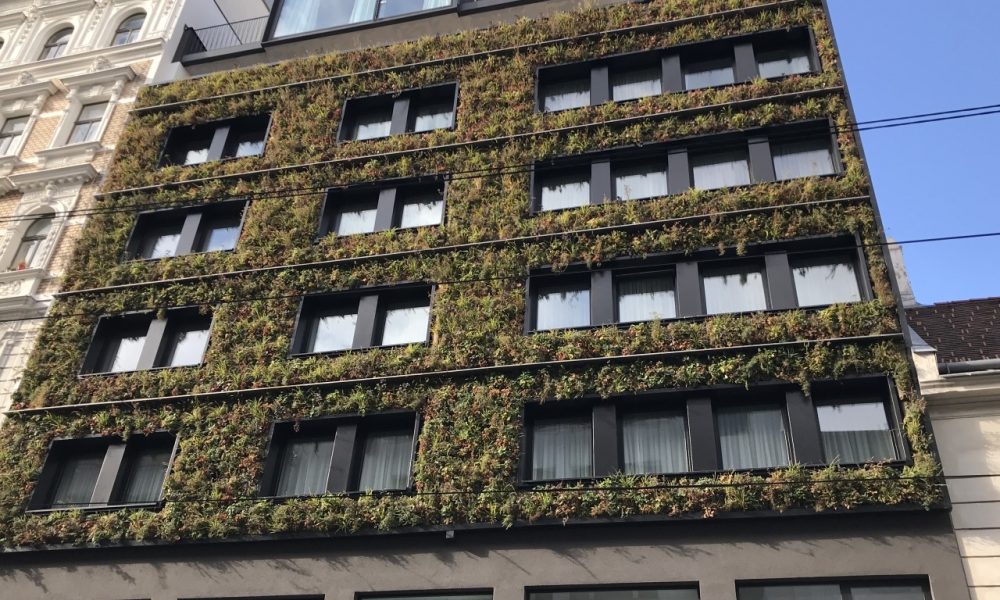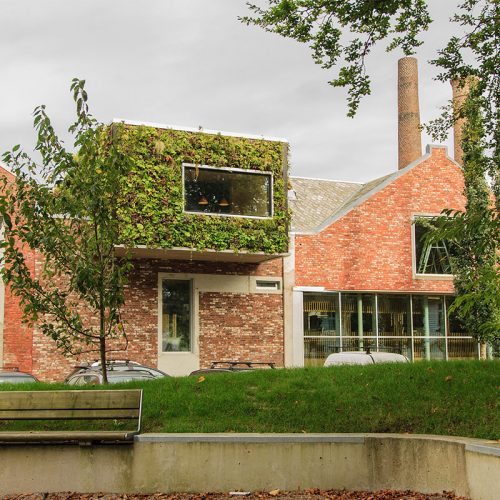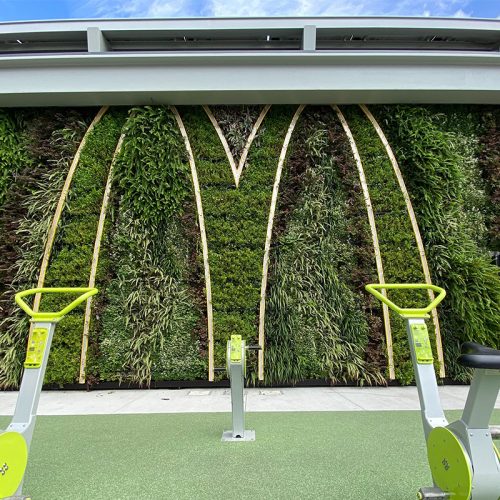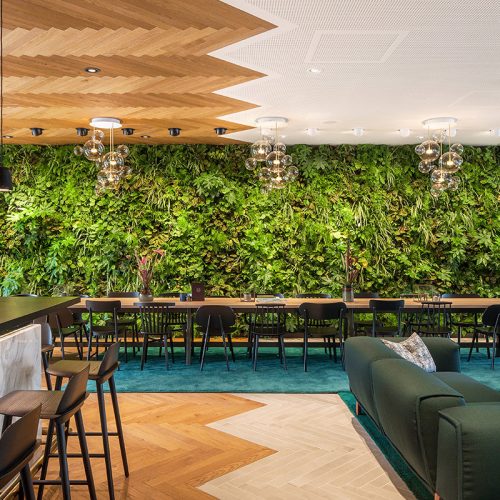A living wall is planted with a combination of different plants. We are often asked which plants we use in our green facades. Thanks to years of experience with the cultivation process and maintenance of green walls, we have carefully compiled several standard plant assortments that are suitable for many sun orientations, wind directions and climates. Lenhard van Ballegooijen, director of Sempergreen Nurseries, and Peter van Klaveren, maintenance specialist at Sempergreen Vertical Systems, explain passionately in this article what criteria underlie the plant selection for a living wall.
Criteria for plant selection
“ We have developed our plant assortments through a process of trial and error,” explains Lenhard van Ballegooijen. “It has been a continuous process of trying out and seeing how plants behave under various conditions. From years of testing in the greenhouse and experiences we got back from our maintenance team, we’ve developed a large amount of expert knowledge. From this expertise, standard plant assortments have emerged of which we can now confidently say that we offer the most optimised plant selection for every situation and project.”
1. Sun orientation
Van Ballegooijen: “Sun orientation is the first and foremost criterion when selecting plants for a green facade. Sunlight is decisive for the flowering of plants. Our standard plant mix always consists of a combination of hardy (and therefore always evergreen) and flowering plants. Flowering plants are often deciduous plants. These plants lose their leaves in autumn and come back in spring with new leaves and flowers. For a vertical garden with little light, e.g. due to a north or northwest-facing location, we offer two plant assortments especially for these type of projects. These plant selections include only hardy evergreens that thrive in semi-shade or shade conditions.”
2. Flowering period
“In a planting plan for a vertical garden, we also take into account the flowering periods of the plants. We ensure that the flowering periods follow each other as much as possible, so that the facade is in bloom from spring to late summer. Beautiful flowering plants include Geranium sangineum and Potentilla fruticosa,” says Van Ballegooijen.
3. Flower colour
“Another aspect is the flower colour. Sometimes customers have a preference for a specific colour. For these projects, we have developed two planting schemes, which are perfectly matched in terms of colour. So, in addition to the standard range, customers can choose a customised planting scheme with a variety of flower colours. For example, blue-purple plants such as Campanula poscharskyanam, Geranium renardii and Veronica prostrata. Or choose a more yellow-coloured floral display with plants such as Hypericum calycinum, Iberis sempervirens and Waldsteinia ternata.”
4. Leaf colour
“By the way, we do not only look at the colour of the flowers, but also at the colour of the leaves. By accentuating the leaf colour of the plants, a SemperGreenwall has an energetic look even outside the flowering periods. Different leaf colours can very well be combined. For example, fresh green and dark green leaves go well with more grey and red leaf colours. Leaf and flower colours can also be used to create beautiful patterns in a wall, if a customer so wishes.”
5. Leaf size
Peter van Klaveren adds: “In the plant mix, we also consider the leaf size. Combining plants with large and smaller leaves gives a nice 3D effect. Moreover, large leaves create a nice coverage of the wall. We take great care that the leaves do not grow so large that they overgrow the other plants and make sure all of them receive sufficient sunlight. This is an important balance that we are always looking for. Maintenance of a green wall plays a major role here, to preserve the diversity of the plants.”
6. Root system
“In our plant selection, we also always assess the degree of rooting of the plant. The stronger the roots, the stronger the plant. This is why we always choose plants that develop a strong root system and are therefore well suited for vertical growth.”
7. Wind resistance
“Plants in an outdoor green facade should also be resistant to wind. Again, rooting is important. The stronger the roots of a plant, the better it can withstand strong wind conditions. Also, the higher the living wall, the more wind a green facade will catch. A good example of this is the Eden Tower project in Frankfurt, one of the tallest green facade projects in Europe. Here, the green facades reach as high as 98 metres and include a total of 185,000 plants, spread over more than 2,000 m². To prevent plant failure at this height, wind resistance is extremely important.”
8. Water requirements
“We also always look carefully at a plant’s water requirements. There can be a great difference in water requirements between different plant species. Without water, plants will die. So if you place plants together where one plant needs a lot of water and the other needs very little, one of the plant species will not survive. That is why we look for species that are very similar in terms of water requirements. This way we can always give the right amount of water via the automatic Plant Care System.”
9. Climate
“Finally, the local climate determines plant selection for a living wall project. Our standard range is suitable for almost any climate, from maritime to continental and from cold northern to warm southern climates. However, we can add accents, for example. For green facades installed on the coast, we will mainly select hardy plants and grasses, such as Calex oshimensis and Alchillea millefolium. These are plants with a high salt resistance.”
Standard assortment SemperGreenwall Outdoor
Van Ballegooijen continues: “Our standard plant mix for an outdoor green facade consists of 19 different species of plants, with different flowering periods, flower and leaf colours. This selection is a combination of sun and semi-shade plants, and an interplay between deciduous and hardy plants. 25 plants are planted per panel. This is done randomly, which results in a lively wall with a great diversity of plants.”
Assortments for a north-facing living wall
“If you opt for a vertical garden in a low-light location, you need to adjust your plant selection accordingly. Since the choice of flowering plants is limited, we put the colour accents here in leaf colour. For a north-facing green facade, two different standard assortments have been developed; a Red-shade mix with plants such as Ajuga reptans, Bergenia cordifolia and Physocarpus opulifoloius; and a Green-shade mix with, for example, Euonymus fortinei and Lonicera pileata. Only hardy semi-shade and shade plants are included in both mixes, making these facades excellent for shady conditions.”
Standard indoor assortment
“A standard assortment is also available for an indoor green wall. The choice of indoor plants is smaller than for outdoor plants, as there are simply fewer of them available. For an indoor SemperGreenwall, we plant 20 plants per panel. The size of the plants is carefully matched. We also look closely at the water requirements of the various plants and the amount of light available. If an indoor green wall is installed in a dark place, we always advise adding extra lighting so that the plants remain in good health even in dark conditions,” says Van Klaveren. “Plants that do well in an indoor living wall include Epipremnum aureum, Philodendron scandens and Spathiphyllum. These plants also have an extra high air-purifying effect!”
Plant choice according to preference
“Sometimes we get asked if we can also plant a green facade with plants selected by the customer. We certainly can! For this purpose, we have a list of 40 to 50 outdoor plant species and 20 indoor plants available for customers to choose from. We know the specific qualities of all these plants, whether they are suitable for vertical growth and how they behave under various conditions. For example, if it concerns a green wall in an extreme climate, we explain that it is wise to choose plants that are suitable for this situation. This way, together with the customer, we always achieve the best result for their living wall project.”
“A good example of a customized living wall is the MCX Apeldoorn project. Here, the customer wanted only two plants incorporated in the wall; Pachisandra terminalis ‘green sheen’ and Euonymus fortunei ‘Radicans’. We then check whether these plants match each other in terms of water requirements, leaf growth and rooting. That turned out to be the case and this is how you get a beautiful result according to the customer’s wishes. Spa Zuiver in Amsterdam is another example of such a project. We are now working on a project in France, which will be designed and planted entirely according to the customer’s wishes,” Van Ballegooijen concludes.
Delivery from stock
“If we are in the growing season, i.e. spring, the minimum growing period is 14 to 16 weeks. If we receive an order outside the growing season, this period will be longer because it takes more time for the plants to mature in the living wall system. But normally, projects are notified to us well in advance so that we have enough time to grow a green facade for the project. Fortunately, we always keep a base stock, so should a project need to be delivered quickly, we can often find a way around that.”
Would you like to know more about our plants?
Want to know more about which plant assortments we use for our living walls? Feel free to contact one of our green wall specialists.





